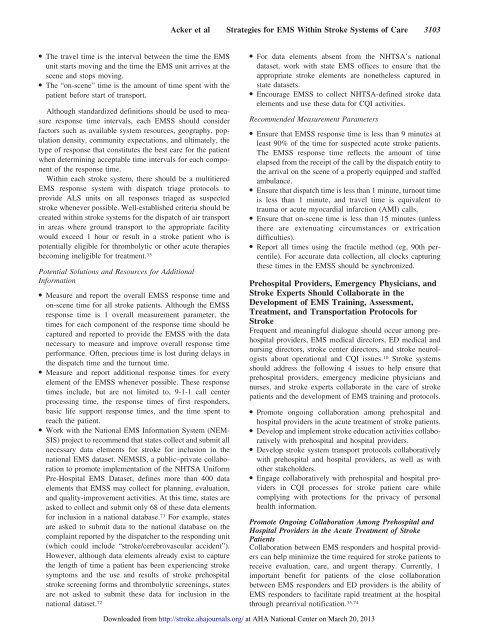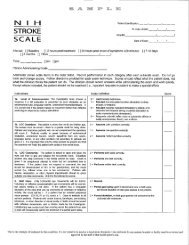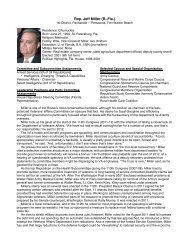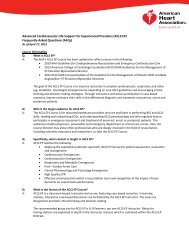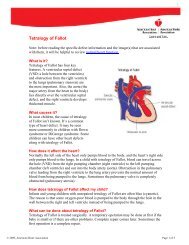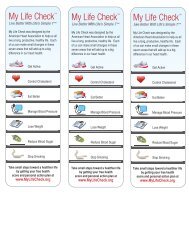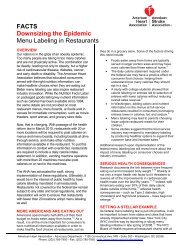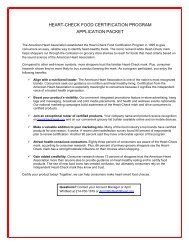2007 EMS Stroke Recommendations - American Heart Association
2007 EMS Stroke Recommendations - American Heart Association
2007 EMS Stroke Recommendations - American Heart Association
Create successful ePaper yourself
Turn your PDF publications into a flip-book with our unique Google optimized e-Paper software.
Acker et al Strategies for <strong>EMS</strong> Within <strong>Stroke</strong> Systems of Care 3103<br />
● The travel time is the interval between the time the <strong>EMS</strong><br />
unit starts moving and the time the <strong>EMS</strong> unit arrives at the<br />
scene and stops moving.<br />
● The “on-scene” time is the amount of time spent with the<br />
patient before start of transport.<br />
Although standardized definitions should be used to measure<br />
response time intervals, each <strong>EMS</strong>S should consider<br />
factors such as available system resources, geography, population<br />
density, community expectations, and ultimately, the<br />
type of response that constitutes the best care for the patient<br />
when determining acceptable time intervals for each component<br />
of the response time.<br />
Within each stroke system, there should be a multitiered<br />
<strong>EMS</strong> response system with dispatch triage protocols to<br />
provide ALS units on all responses triaged as suspected<br />
stroke whenever possible. Well-established criteria should be<br />
created within stroke systems for the dispatch of air transport<br />
in areas where ground transport to the appropriate facility<br />
would exceed 1 hour or result in a stroke patient who is<br />
potentially eligible for thrombolytic or other acute therapies<br />
becoming ineligible for treatment. 35<br />
Potential Solutions and Resources for Additional<br />
Information<br />
● Measure and report the overall <strong>EMS</strong>S response time and<br />
on-scene time for all stroke patients. Although the <strong>EMS</strong>S<br />
response time is 1 overall measurement parameter, the<br />
times for each component of the response time should be<br />
captured and reported to provide the <strong>EMS</strong>S with the data<br />
necessary to measure and improve overall response time<br />
performance. Often, precious time is lost during delays in<br />
the dispatch time and the turnout time.<br />
● Measure and report additional response times for every<br />
element of the <strong>EMS</strong>S whenever possible. These response<br />
times include, but are not limited to, 9-1-1 call center<br />
processing time, the response times of first responders,<br />
basic life support response times, and the time spent to<br />
reach the patient.<br />
● Work with the National <strong>EMS</strong> Information System (NEM-<br />
SIS) project to recommend that states collect and submit all<br />
necessary data elements for stroke for inclusion in the<br />
national <strong>EMS</strong> dataset. N<strong>EMS</strong>IS, a public–private collaboration<br />
to promote implementation of the NHTSA Uniform<br />
Pre-Hospital <strong>EMS</strong> Dataset, defines more than 400 data<br />
elements that <strong>EMS</strong>S may collect for planning, evaluation,<br />
and quality-improvement activities. At this time, states are<br />
asked to collect and submit only 68 of these data elements<br />
for inclusion in a national database. 73 For example, states<br />
are asked to submit data to the national database on the<br />
complaint reported by the dispatcher to the responding unit<br />
(which could include “stroke/cerebrovascular accident”).<br />
However, although data elements already exist to capture<br />
the length of time a patient has been experiencing stroke<br />
symptoms and the use and results of stroke prehospital<br />
stroke screening forms and thrombolytic screenings, states<br />
are not asked to submit these data for inclusion in the<br />
national dataset. 72<br />
● For data elements absent from the NHTSA’s national<br />
dataset, work with state <strong>EMS</strong> offices to ensure that the<br />
appropriate stroke elements are nonetheless captured in<br />
state datasets.<br />
● Encourage <strong>EMS</strong>S to collect NHTSA-defined stroke data<br />
elements and use these data for CQI activities.<br />
Recommended Measurement Parameters<br />
● Ensure that <strong>EMS</strong>S response time is less than 9 minutes at<br />
least 90% of the time for suspected acute stroke patients.<br />
The <strong>EMS</strong>S response time reflects the amount of time<br />
elapsed from the receipt of the call by the dispatch entity to<br />
the arrival on the scene of a properly equipped and staffed<br />
ambulance.<br />
● Ensure that dispatch time is less than 1 minute, turnout time<br />
is less than 1 minute, and travel time is equivalent to<br />
trauma or acute myocardial infarction (AMI) calls.<br />
● Ensure that on-scene time is less than 15 minutes (unless<br />
there are extenuating circumstances or extrication<br />
difficulties).<br />
● Report all times using the fractile method (eg, 90th percentile).<br />
For accurate data collection, all clocks capturing<br />
these times in the <strong>EMS</strong>S should be synchronized.<br />
Prehospital Providers, Emergency Physicians, and<br />
<strong>Stroke</strong> Experts Should Collaborate in the<br />
Development of <strong>EMS</strong> Training, Assessment,<br />
Treatment, and Transportation Protocols for<br />
<strong>Stroke</strong><br />
Frequent and meaningful dialogue should occur among prehospital<br />
providers, <strong>EMS</strong> medical directors, ED medical and<br />
nursing directors, stroke center directors, and stroke neurologists<br />
about operational and CQI issues. 10 <strong>Stroke</strong> systems<br />
should address the following 4 issues to help ensure that<br />
prehospital providers, emergency medicine physicians and<br />
nurses, and stroke experts collaborate in the care of stroke<br />
patients and the development of <strong>EMS</strong> training and protocols.<br />
● Promote ongoing collaboration among prehospital and<br />
hospital providers in the acute treatment of stroke patients.<br />
● Develop and implement stroke education activities collaboratively<br />
with prehospital and hospital providers.<br />
● Develop stroke system transport protocols collaboratively<br />
with prehospital and hospital providers, as well as with<br />
other stakeholders.<br />
● Engage collaboratively with prehospital and hospital providers<br />
in CQI processes for stroke patient care while<br />
complying with protections for the privacy of personal<br />
health information.<br />
Promote Ongoing Collaboration Among Prehospital and<br />
Hospital Providers in the Acute Treatment of <strong>Stroke</strong><br />
Patients<br />
Collaboration between <strong>EMS</strong> responders and hospital providers<br />
can help minimize the time required for stroke patients to<br />
receive evaluation, care, and urgent therapy. Currently, 1<br />
important benefit for patients of the close collaboration<br />
between <strong>EMS</strong> responders and ED providers is the ability of<br />
<strong>EMS</strong> responders to facilitate rapid treatment at the hospital<br />
through prearrival notification. 35,74<br />
Downloaded from http://stroke.ahajournals.org/ at AHA National Center on March 20, 2013


